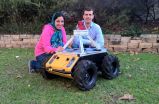Risky outdoor play positively impacts children's health: UBC study
2015-06-10
New research from UBC and the Child & Family Research Institute at BC Children's Hospital shows that risky outdoor play is not only good for children's health but also encourages creativity, social skills and resilience.
The findings, published in the International Journal of Environmental Research and Public Health, found that children who participated in physical activity such as climbing and jumping, rough and tumble play and exploring alone, displayed greater physical and social health.
"We found that play environments where children could take risks promoted increased ...
Interest in learning about skin cancer appears to increase during summer
2015-06-10
Google searches for information on melanoma and skin cancer increased over the summer months during a five-year period, although the level of interest did not correlate with the melanoma mortality to incidence ratio, suggesting that increased search volumes may not be associated with early detection, according to a research letter published online by JAMA Dermatology.
Researcher Kyle T. Amber, M.D., of MacNeal Hospital, Berwyn, Ill., and coauthors used Google Trends, a research tool which quantifies interest in topics at the population level by analyzing all search queries ...
Probing what happens to plutonium in a nuclear explosion
2015-06-10
For years, research on nuclear weapons has relied on old data, limited experiments and computer modeling. But this year, that pattern has changed. Scientists have run new experiments that simulate what happens to plutonium in a nuclear explosion, according to an article in Chemical & Engineering News (C&EN), the weekly newsmagazine of the American Chemical Society. The research will deepen scientists' understanding of the element -- and help them analyze a nuclear event should one occur.
In the article, Jyllian Kemsley, a senior editor at C&EN, notes that six years ago, ...
New obesity treatment prevents bone loss during weight loss
2015-06-10
Using the intestinal hormone GLP-1 in obesity treatment prevents the loss of bone mass otherwise frequently associated with major weight loss. This is the finding of a new study from the University of Copenhagen, Hvidovre and Glostrup Hospital. According to the researchers behind the study, the results may have a significant bearing on future obesity treatment.
Rapid weight loss leads to a loss of bone mass and an increased risk of bone fractures. New research shows that treating obesity with the GLP-1 hormone helps prevent loss of bone mass in addition to having a number ...
Energy efficiency upgrades ease strain of high energy bills in low-income families
2015-06-10
June 10, 2015--Low-income families bear the brunt of high-energy costs and poor thermal comfort from poorly maintained apartment buildings. To study how energy efficiency upgrades could help these households, researchers at Columbia University's Mailman School of Public Health surveyed residents in a low-income community in New York City. They found that while energy efficiency upgrades varied significantly by ownership status, low-income single-family homeowners reaped the greatest direct benefits. Results overall showed that respondents experienced improved thermal comfort, ...
New report says US freight rail regulations outdated, recommends modernization efforts
2015-06-10
WASHINGTON - While a 1980 reform law enabled the modernization and stabilization of the U.S. freight railroad industry, federal regulation has not kept pace with the industry's transformation and should be replaced with a system better-suited for today's freight rail system, says a new congressionally mandated report from the National Research Council's Transportation Research Board. Current policies designed to protect rail shippers who lack transportation options from excessive rates are not working for shippers of most commodities, including grain. More appropriate, ...
Robot eyes will benefit from insect vision
2015-06-10
The way insects see and track their prey is being applied to a new robot under development at the University of Adelaide, in the hopes of improving robot visual systems.
The project - which crosses the boundaries of neuroscience, mechanical engineering and computer science - builds on years of research into insect vision at the University.
In a new paper published today in the Journal of The Royal Society Interface, researchers describe how the learnings from both insects and humans can be applied in a model virtual reality simulation, enabling an artificial intelligence ...
Statewide quality improvement program helps lower rates of trauma complications
2015-06-10
CHICAGO (June 10, 2015): As health insurers place more emphasis on paying for quality outcomes rather than for specific services provided by doctors and hospitals, several quality improvement programs have been developed as a way to help health care providers identify problem areas and share best practices. While some studies have evaluated how well these quality improvement programs achieve their goals, not many have focused on the area of trauma care. But now a team of trauma surgeons at the University of Michigan in Ann Arbor have reported how data from a statewide ...
Binghamton engineer creates origami battery
2015-06-10
Origami, the Japanese art of paper folding, can be used to create beautiful birds, frogs and other small sculptures. Now a Binghamton University engineer says the technique can be applied to building batteries, too.
Seokheun "Sean" Choi developed an inexpensive, bacteria-powered battery made from paper, he writes in the July edition of the journal Nano Energy.
The battery generates power from microbial respiration, delivering enough energy to run a paper-based biosensor with nothing more than a drop of bacteria-containing liquid. "Dirty water has a lot of organic matter," ...
Partial sleep deprivation linked to biological aging in older adults
2015-06-10
DARIEN, IL - A new study suggests that one night of partial sleep deprivation promotes biological aging in older adults.
Results show that one night of partial sleep deprivation activates gene expression patterns in peripheral blood mononuclear cells (PBMCs) consistent with increasing accumulation of damage that initiates cell cycle arrest and increases susceptibility to senescence. These findings causally link sleep deprivation to the etiology of biological aging, and further supports the hypothesis that sleep deprivation may be associated with elevated disease risk ...
Public debate could be key to strong economy
2015-06-10
As it turns out, people who speak their minds loudly and often could be responsible for economic prosperity.
That's according to a new study by Michigan State University economist Siddharth Chandra, director of MSU's Asian Studies Center, and Nita Rudra, associate professor in the Department of Government at Georgetown University.
"Our study demonstrates that freedom to express our opinions is not just something we should enjoy," said Chandra, who's also a professor in MSU's James Madison College. "It could have very important consequences - sometimes preventing the ...
Sleep duration and quality may impact cancer survival rate
2015-06-10
DARIEN, IL - A new study suggests that pre-diagnostic short sleep duration and frequent snoring were associated with significantly poorer cancer-specific survival, particularly among women with breast cancer.
Results show that stratified by cancer site, short sleep duration and frequent snoring were associated with significantly poorer breast cancer-specific survival.
"Our results suggest that sleep duration is important for breast cancer survival, particularly in women who snore," said lead author Amanda Phipps, assistant professor of epidemiology at the University ...
This week from AGU: Space weather warnings, real-time water management
2015-06-10
From AGU's blogs: New Tool Could Track Space Weather 24 Hours Before Reaching Earth
A new model, described in a June 9 paper in the journal Space Weather, might finally give scientists a tool to predict a coronal mass ejection's magnetic configuration from afar, which means forecasters could give utility grid and satellite operators a full 24-hour advance warning to protect their systems.
From AGU's journals: Satellite Measurements May Help Real-Time Water Management
With the demand for water stored in reservoirs rising in many areas, it is becoming increasingly ...
A stiff upper lip makes sense to baby
2015-06-10
This news release is available in French. Montreal, June 10, 2015 -- When you're one and a half years old, having your favourite ball taken away is likely to result in a temper tantrum. But while babies wear their feelings on the sleeves of their onesies, adults often mask their emotions, responding to life's disappointments with stoic reserve.
While you might think that witnessing such reactions would confuse toddlers and lead them to believe emotionally reserved adults aren't being honest -- so by extension are untrustworthy to begin with -- new research shows ...
Teenagers should exercise like kids to achieve best health outcomes
2015-06-10
As little as two minutes of high-intensity exercise four times a day improves health outcomes in adolescents, but the same amount of moderate-intensity exercise does not reap the same rewards, according to a new study from the University of Exeter.
Researchers found that when exercise is broken up into short bursts over the course of a day - replicating the way young children go about being active - only high-intensity exercise is effective in improving blood sugar levels, fat metabolism and blood pressure in adolescents after the consumption of a fatty meal.
The ...
Pedophiles more likely to have physical irregularities
2015-06-10
New research suggests pedophiles are more likely to have superficial facial flaws, known as Minor Physical Anomalies (MPAs). They are also more likely to be left-handed, says Fiona Dyshniku of the University of Windsor in Canada. She led an investigation into the prevalence and distribution of physical anomalies among men who are sent for sexological assessment. The study in Springer's journal Archives of Sexual Behavior adds to a growing body of evidence that suggests pedophilia develops prenatally, around the same time that such physical flaws develop.
"Evidence is ...
The price of a happy ending can be bad decision-making, say researchers
2015-06-10
New research using high-speed gambling experiments shows that, for most of us, the last experience we've had can be the defining one when it comes to taking a decision, coming at the expense of other experiences we've accumulated further back in time.
The study, published today in the journal Proceedings of the Royal Society B, supports the idea that the 'banker's fallacy' - focusing on immediate growth at the expense of longer-term stability that would produce better results - is intuitive in the way many of us make quick decisions.
People's natural inclination towards ...
Finding hope in the dark
2015-06-10
Advances in stem cell transplantation and gene therapy have been pioneered in vision research. An international team of researchers from Bristol, Toronto, Pittsburgh, Dallas and Montreal have identified a gene that could be responsible for some cases of human night blindness.
Leber's congenital amaurosis (LCA) is a group of hereditary retinal diseases that result in severe loss of vision in early childhood and is estimated to affect around 1 in 80,000 of the population. Recent clinical trials of gene therapy for LCA have shown early promising results in treated patients ...
Impact of insecticides on the cognitive development of 6-year-old children
2015-06-10
This news release is available in French. In an article published in the journal Environment International, researchers from Inserm (Inserm Unit 1085 - IRSET, the Institute of Research in Environmental and Occupational Health, Rennes), in association with the Laboratory for Developmental and Educational Psychology, LPDE (Rennes 2 University), provide new evidence of neurotoxicity in humans from pyrethroid insecticides, which are found in a wide variety of products and uses. An increase in the urinary levels of two pyrethroid metabolites (3-PBA and cis-DBCA) in children ...
Fast-tracking precision medicine: Drug re-aimed to target diabetic kidney disease
2015-06-10
ANN ARBOR, Mich. - It started out as a treatment for arthritis. But steered by science, it could become a first new approach in two decades for treating the damage that diabetes inflicts on the kidneys of millions of people.
This past weekend, University of Michigan Medical School researchers and their colleagues presented promising results from a clinical trial of the experimental drug baricitinib in people with diabetic kidney disease. In a randomized, controlled Phase II study, it reduced a key sign of kidney damage, with higher doses producing the largest effect, ...
Nanoparticles target and kill cancer stem cells that drive tumor growth
2015-06-10
Many cancer patients survive treatment only to have a recurrence within a few years. Recurrences and tumor spreading are likely due to cancer stem cells that can be tough to kill with conventional cancer drugs. But now researchers have designed nanoparticles that specifically target these hardy cells to deliver a drug. The nanoparticle treatment, reported in the journal ACS Nano, worked far better than the drug alone in mice.
Anti-cancer drugs can often shrink tumors but don't kill cancer stem cells (CSCs). Although CSCs might only make up a small part of a tumor, their ...
Cutting carbon emissions could have indirect effects on hunger
2015-06-10
As many of the world's nations prepare and implement plans to cut greenhouse gas emissions, researchers say another critical factor needs to be considered. A new study has found for the first time that efforts to keep global temperatures in check will likely lead to more people going hungry. That risk, they say in the ACS journal Environmental Science & Technology, doesn't negate the need for mitigation but highlights the importance of comprehensive policies.
Previous studies have shown that climate change reduces how much food farms can produce, which could lead to ...
Social media should play greater role in disaster communication
2015-06-10
When Typhoon Haiyan slammed into the Philippines in 2013, thousands of people were killed, in part because they didn't know it was coming or didn't know how to protect themselves.
Could an increased use of social media, particularly on the part of the nation's government, have made a difference?
While that question remains open, it is clear that social media should play a larger role in emergency preparedness, says Bruno Takahashi, a Michigan State University assistant professor of journalism who studies the issue.
Using the Philippines' typhoon as a case study, Takahashi ...
Lost in space
2015-06-10
Although the Universe may seem spacious most galaxies are clumped together in groups or clusters and a neighbour is never far away. But this galaxy, known as NGC 6503, has found itself in a lonely position, shown here at the edge of a strangely empty patch of space called the Local Void. This new NASA/ESA Hubble Space Telescope image shows a very rich set of colours, adding to the detail seen in previous images.
NGC 6503 is only some 18 million light-years away from us in the constellation of Draco (The Dragon), making it one of the closest neighbours from our Local Group. ...
Tackling chronic sinusitis by addressing underlying factors
2015-06-10
The stuffy noses and sinus pressure of head colds are uncomfortable, but for most people, they go away within days. For those with chronic sinusitis, however, those symptoms and others drag on for weeks. Now scientists are onto a potential new therapy that could address one of the underlying factors associated with the condition. They describe their work in the ACS journal Molecular Pharmaceutics.
In the body, nitric oxide (NO) plays a critical role in immunity. Researchers have found that this simple molecule is an important antimicrobial agent that helps prevent sinus ...
[1] ... [2818]
[2819]
[2820]
[2821]
[2822]
[2823]
[2824]
[2825]
2826
[2827]
[2828]
[2829]
[2830]
[2831]
[2832]
[2833]
[2834]
... [8709]
Press-News.org - Free Press Release Distribution service.


